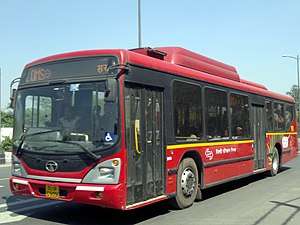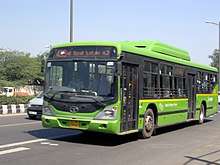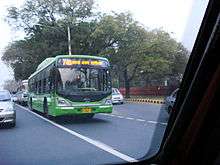Delhi Transport Corporation
Delhi Transport Corporation (DTC) is the main public transport operator of Delhi. It is one of the largest CNG-powered bus service operator in the world.[1]
| Public Sector Corporation under the Government of NCT of Delhi | |
| Industry | Public transport bus service |
| Founded | 1948 |
| Headquarters | , |
Area served | Delhi |
| Products | Bus transport |
| Services | TATA AC Airbus, TATA non-AC Airbus, Local sight seeing, Inter-state bus service |
Number of employees | 18000 |
| Website |




History
The Delhi Transport Corporation was incorporated in May 1948 by the Indian government for local bus services when they found out the incumbent service provider Gwalior and Northern India Transport Company Ltd. was inadequate in serving the purpose. It was then named "Delhi Transport Service". It was again constituted as "Delhi Road Transport Authority" under the Road Transport Corporation Act, 1950. This Authority became an undertaking of Municipal Corporation of Delhi by an Act of Parliament in April, 1958. In 1971, on a recommendation from the Indian government took over the assets and liabilities from the erstwhile Delhi Transport Undertaking (DTU) operated by the Municipal Corporation of Delhi until 2 November 1971. Delhi Transport Corporation which was under administrative control of the Indian government was transferred to the Government of National Capital Territory, Delhi. Beginning in October 2019, New Delhi began rolling out free bus transit for women on the Delhi Transport Corporation, with women traveling for free when using pink tickets.[2]
Routes
Delhi Transport Corporation operates on many routes in Delhi and neighbouring States. The mofussil buses operate around 46 depots out of which 18 depots are of old DTC buses and rest have low floor buses while the inter-state buses operate from the Three Inter State Bus Terminals in Kashmiri Gate, Sarai Kale Khan and Anand Vihar.
Intra-Delhi bus services
Delhi Transport Corporation services in Delhi has vastly distributed network of bus services. It connects almost every part of Delhi with this network of buses. The most Prominent of these being the Mudrika and the Bahri Mudrika Seva services interconnecting all parts of the city with a great frequency of buses until approximately 10:30 p.m.
High capacity bus service
Delhi Transport Corporation has started High Capacity Bus Service on a few routes and work is in progress to develop more high capacity bus routes. This service uses buses with improved carrying capacity and better facilities like air-conditioning, less travel time, less congestion, more comfortable interiors, GPS navigation etc. And now in the list of High Capacity Buses is the new, sleek, red coloured air-conditioned buses of the Delhi Transport Corporation, which was inaugurated by Chief Minister Sheila Dikshit on 4 June 2008 during the celebrations of World Environment Day in the Capital at India Gate. Chief Minister Sheila Dikshit flagged off the eight new air-conditioned Red Line buses, which will initially ply on select routes in the capital, of which two will be on the newly constructed bus rapid transport corridor. The minimum bus fare starts at ₹5 and the maximum is ₹25(excluding passes, which are of ₹50-55 ).
Fleet
It is having a fleet of 3800 buses, apart from this there are 2400 DIMTS buses, taking total fleet to 6200 buses.
Details
It being stated that there were 5,847 buses functional in Delhi in 2013-14, which went up to 6,118 in 2014-15. The number further increased to 6,659 in 2015-16 and in the next year it went down to 5,826 buses. The number fell to 5,814 in 2017-18 and again rose to 6,578 for the last financial year 2018-19. There are 3,781 buses in DTC's fleet. Majority of these buses are as old as nine years. The last bus that was commissioned was in 2010 before the Commonwealth Games in New Delhi. Around 1700 more to be delivered by Tata Marcopolo by the end of 2021.
Delhi Integrated Multi-Modal Transit System (DIMTS)
The buses having a fleet of 1725 buses deployed under the cluster scheme have state-of-the-art technology to guide and monitor them. They have been equipped with Global Positioning System (GPS) devices so that their movement and geographic location are tracked by the Automatic Vehicle Location (AVL) system on real-time basis that provides ETA and other data to the passengers by PoochhO App, the App also has trip planner, pollution status in vicinity and other features. Electronic Ticketing Machines (ETM) are being used on these buses in place of pre-printed tickets as part of the automated fare collection (AFC) system, since August 2018 it is possible to use DMRC Metro Card to buy tickets in DIMTS' buses. Under the scheme the private concessionaires, who would be allotted clusters, would bring in their buses, arrange for their cleaning and maintenance and provide for the staff. For the services rendered, the concessionaire would be paid on the basis of an indexed cost system that would have a fixed component based on the cost of the bus, a variable component that would factor in the fuel and maintenance costs and a component that would deal with the wages cost keeping in mind the consumer price index.
Inter-state bus services

DTC was one of the premier bus services of North India. Which connects almost all the major centres of North India with its services. At present Interstate bus service is suspended. It covers only few area of NCR.